Reducing Exposure to Deer Ticks and Lyme Disease with Bay Leaves Updated 6/14/2017
Updated 6/14/2017
Dr. Nevena Zubcevik described deer tick nymphs as “the perfect vector” because of their diminutive size — the size of the “D” on a dime — and because of the analgesic in their saliva that often makes their bite almost undetectable.
Introduction
Let me first say that I am not an expert but am a student of nature with many years of daily experience in the field were deer tick and Lyme Disease can be found, so let me share with you what I’ve observed and learned over the years.
It is March and after a hike in the forest in the Santa Cruz mountains last week I took the first tick off of Blaze, our 12 year old mid size dog, so tick season has started and tick prevention needs to be revisited. Lyme disease Borrelia burgdorferi is prevalent in the deer ticks and deer ticks are found most anywhere deer or wood rats are found.
Many of my friends or staff have or have family members that have or had Lyme Disease. Lyme may first show up as a rash followed by flu like symptoms. If caught early and hammered with antibiotics Lyme can be easily treated. However, if left untreated Lyme could be very debilitating with the following symptoms.
- Pain and/or swelling of joints
- Disabling neurological disorders (disorientation; confusion; dizziness; short-term memory loss; inability to concentrate, finish sentences or follow conversations; mental “fog”)
- Numbness in arms, hands or legs/feet
With these symptoms may come brain and liver damage.
Makes you want to not leave the safety of your cubical and computer screen.
Two-Year Life Cycle of the Deer Tick
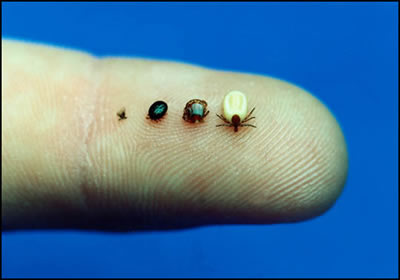
Deer is where the deer tick breeds. After breeding and the female engorges on blood she will drop off and lay her eggs on the soil, grass, leaf litter, or carpet.
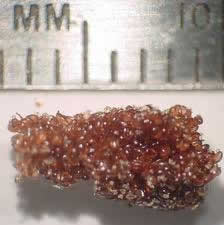
The eggs overwinter, hatch come spring, and will have its first meal as a larvae on a bird, mouse, raccoon, lizard… Are you getting the point here? They can feed on vertebrates. Then will drop to the ground to molt and become a nymph and may overwinter. You should have just had an Ah Ha moment. Think about it if a bird can get a tick where the deer live in spring and then perches on a tree in your yard come summer you will have deer ticks in your yard anywhere. In the image below you can easly see the adalesent ticks but look at the ear and you will see the larvae.
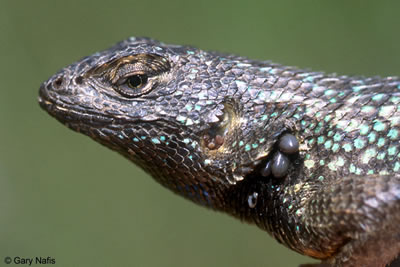
Come spring the tick will feed for the second time on some mammal be it mouse, deer, you, or your child. After a good meal of blood it will drop to the earth and molt to become an adult.
As an adult it would prefer a deer but a dog, raccoon or you will do, it will breed, feed, then fall to earth to start the next generation.
If any of the early hosts were infected with Lyme Disease then the later hosts will now be exposed.

Though this is from 2015 this is the most current information I can find with regard to Lyme Disease within the counties across the US.
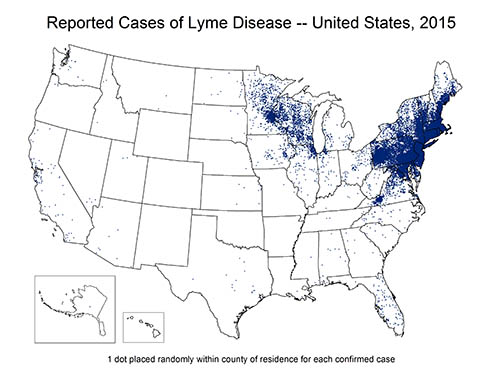
An Ah-HA Moment for Me; Wood Rats Use Bay Leaves to Control Ectoparasites
If you follow the Center for Disease Control, you will not go into the woods, but if you find you must go into the woods the CDC does not want you to go off trail and wants you to spray yourself with 20% DEET and spray your clothes with Permethrin. These are not options I want to practice.
I have lived much of my life in rural areas where ticks are found and I live a lifestyle that I should have been getting ticks frequently over the course of my 1/2 century of being in nature. If you have known me for any length of time you know that I work daily 7 hours a day in tick country and I like to kick back in the cool grass, enjoy the sun and take a lunch time power nap on ground, but I have not had to remove a single tick from my skin, at least until I changed a practice that I had been doing all my life and then I got 3 in the coarse of 1 1/2 years. I have gone back to that practice yet still hike, track, and nap in the woods and meadows without getting ticks.
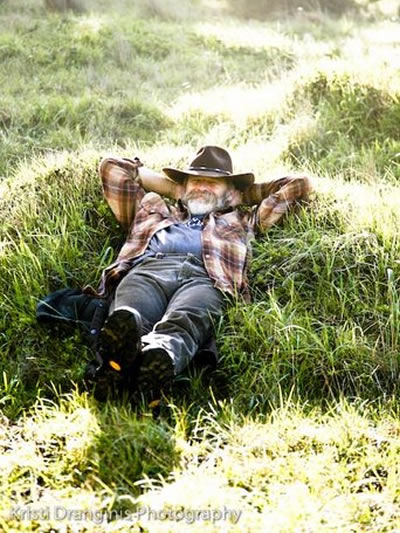
Over the years I have tracked pig, bobcat, and fox and sometimes find myself crawling in tunnels found in poison oak, coyote brush, and willows. The deer use many of these and the ticks get brushed off on to the ground. I should have had ticks but not one (since I worte that I have been bit 2 times by ticks each time when I was traveling and someone else was laundering my cloths and not stored with bay leaves). I would actually see the ticks get on my cloths but not linger or feed on me. In 2000 I read a scholarly report on wood rat behavior that reinforces my practice.
A practice that my aunt and my mother religiously did and then I half heartily continued as an adult was to crumple up the leaves of the California Bay Laurel (Umbellularia californica) and put them in our dresser drawers. If you were to ask my aunt she would tell you it was to keep the silverfish and moths out of our cloths. When I would go into the woods I would rub bay leaves on my hair and exposed skin to cover up my sent. I also put bay leaves in the dryer and sometimes put the leaves in my drawers.
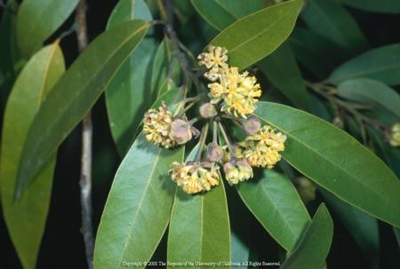
One a spring day, this past year, the mosquitos were quite a bother for the students trying to work along the creek. I watched the youngest student grab a fist full of leaves from suckers at the base of a century old bay, crumple them up and rub his face and neck, and then fill his hat with them. The mosquitos continued to cloud around him but stopped landing on him, the rest of the students followed suit and were able to continue to work, but that is for another post.
Richard B. Hemmes , Arlene Alvarado and Benjamin L. Hart from Vassar University NY conducted a study in Sonoma, California. The study was to test the hypothesis that dusky-footed wood rats (Neotoma fuscipes) place bay leaves (Umbellularia californica) on or near the sleeping nest in their stick houses, with the result that the leaves act as a fumigant against nest-borne ectoparasites.
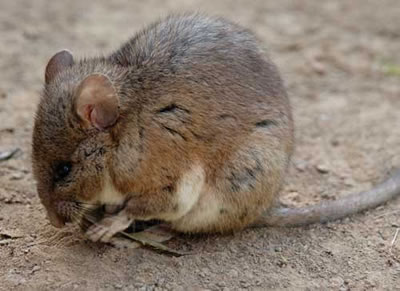
It has been known that wood rats would line their nests with foliage but until this study it was thought that the rodent’s intent was a food larder. The Memmes, Alvarado, and Hart’s study showed that the bay leaves were, in fact not food at all. The major constituents of volatile oils in the foliage of California bay are 1,8-cineole (19%), which is primarily responsible for the leaves’ distinctive odor, and umbellulone (39%), which has been shown to be toxic when fed to laboratory mice probably not what a rat would want to store for food.
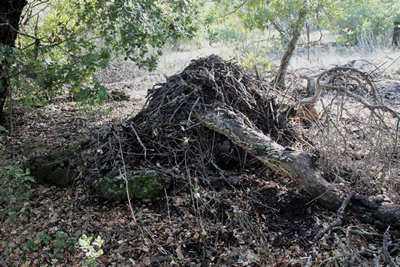
The Hemmes’ team found the bay leaves were found in the sleeping part of the nest not in with the food stores. Additionally the wood rats were bringing in fresh stores of bay leaves every 2 - 3 days.
There was a substantial turnover of bay leaves within 2-3 days, a behavior which could maintain concentration of released volatiles. The pattern of nibbling on bay leaves, typically as small lacerations sporadically along the margin of the leaf, was not suggestive of use of bay for food but did suggest a function in releasing volatiles. Torn bay also significantly reduced survival of flea larvae to 26%.
The wood rats practice not only deter the ectoparasites but actually kills their larvae in their nest. So my Aunt Dolly was keeping us safe from ticks by just gathering some branches from the trees by the creek, crumpling the leaves up and putting them in our dresser.
Best Practices to Limit Exposure to Deer Ticks and Still Enjoy the Wilderness Without Bug Spray
So this is what I do, crumple up bay leaves and put them in the dryer when I dry our cloths. When the clothing is put in the dresser bay leaves are crumpled up in the drawers along with the clothing.
Before I head out into the forest I crumple bay leaves and rub my face, neck, arms, ankles, and hair. The CDC suggests that you tuck your pants in your boots and some suggest putting rubber bands around your sleeves.
Jon Young suggests using Dr. Bronner’s lavender soap and putting lavender in clothing similar to the method that I suggest using bay. I use the lavender soap also.
When returning from a foray in the wilderness, put your cloths directly in the washer not in a clothes hamper. Hop in the shower scrub and do a tick check.
If You Do Get a Tick What Do You Do?
If it is stuck to you, you need to get it out as soon as you can but most importantly without leaving the mouth parts in your skin or having the tick regurgitate its stomach contents in you. Some authorities say you have 24 hours some say 12 before Lyme Disease can be passed to the blood.
Given that information do not squeeze the abdomen with your fingers or fat blunt tweezers, this will literally pump the fluids into patients skin. Do not use heat like a match or cigarette, the myth is the tick will back out, no this practice though popular in the 40s-70s did a fine job of getting the tick to regurgitate. Also popular was twisting clockwise or counterclockwise with the myth that the mouth parts would screw out of the skin, but what this did was break the mouth parts off under the skin. Do not use oil or grease.
What you should do is either use tweezers that can grip only the head without squeezing the abdomen and gently and slowly lift up, until the mouth parts come free. There is also a tool called a tick key that is designed to slide under the head and pull the mouth parts from the skin. I made the same thing in a credit card that works the same way. After removing the tick wipe the site with disinfectant. Only handle the tick with gloves.

Save the tick as per Instructions for shipping live or dead ticks: Clogen Laboratory or better your doctor’s instructions.
If you get a rash (resent research indicates that only 20% of thoes that contract Lyme ever got the rash), suffer any flu like symptoms, or have any concerns see your doctor.
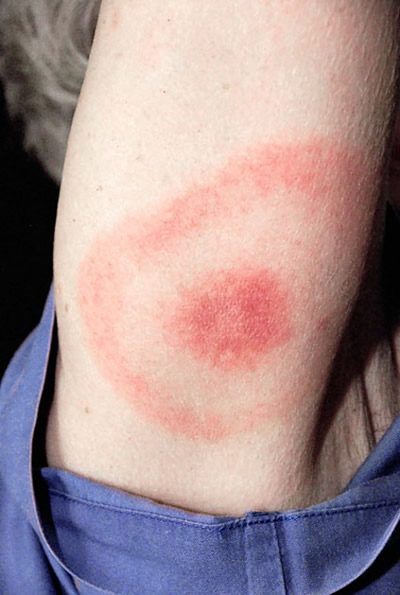
Further Reading
Some reading on the role the western fence lizard may prove to be interesting. If you look at the distribution map of the western fence lizard and the distribution map of reported incidents of Lyme Disease you will not that they are inversely proportional. It is interesting to note that studies have shown that the blood of the western fence lizard significantly reduces the accordance of Lyme Disease in deer ticks found on fence lizards, that fence lizards when exposed to Lyme disease do not get infected with the disease, however, a study conducted her in Marin County indicates reduction deer ticks of the numbers of fence lizards drop.
Bibliography
Protect yourself from tick bites, Center for Disease Control
Use of California bay foliage by wood rats for possible fumigation of nest-borne ectoparasites Richard B. Hemmes, Arlene Alvaradoand Benjamin L. Hart Department of Biology, Vassar College, Poughkeepsie, NY 12604, USA March 17, 1999.
Tick Removal MATTHEW GAMMONS, M.D., and GOHAR SALAM, M.D., D.O.Michigan State University College of Human Medicine, East Lansing, Michigan Am Fam Physician. 2002 Aug 15
Instructions for shipping live or dead ticks: Clogen Laboratory
| Tick population plummets in absence of lizard hosts By Sarah Yang, Media Relations | February 15, 2011 |
Evidence Implicating Nymphal Ixodes pacificus (Acari: Ixodidae) in the Epidemiology of Lyme Disease in California James R. Clover AND Robert S. Lane University of California, Berkeley, California
Susceptibility of the western fence lizard (Sceloporus occidentalis) to the Lyme borreliosis spirochete (Borrelia burgdorferi). Lane RS. University of California, Berkeley